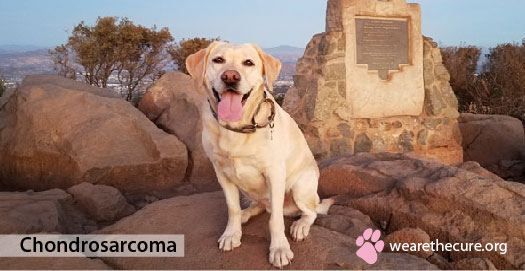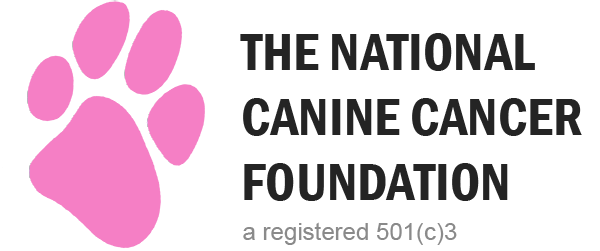Canine Chondrosarcoma Symptoms & Treatment

Chondrosarcoma is a malignant neoplasm accounting for 5%-10% of all primary bone tumors reported in dogs that impacts the cartilage of the bone, typically in the femur and hips.
What are the two types of chondrosarcoma?
- Medullary chondrosarcoma – originates within the bone organ
- Peripheral chondrosarcoma – originates in the periosteum (outer) membrane
The type of chondrosarcoma your dog is diagnosed with depends on where in the skeletal system cancer originates from. In simplistic terms, it can start in either the organs of the bone (medullary) or on the membrane lining on the outer surface of the bone (periosteum). The tumors of medullary origin are most commonly found in dogs.
Where does chondrosarcoma occur in your dog’s body?
The tumor can develop in the nasal cavity, ribs, pelvis, extraskeletal sites like the mammary gland, heart, valves, aorta, larynx, trachea, vertebrae, facial bones, digits, and penis. Central chondrosarcoma of long bones may infiltrate the cortex and supporting layers of the reactive bone. It may also occur in the appendicular skeleton of dogs including sites prone to developing osteosarcoma.
Nasal/Snout Chondrosarcoma
Sadly, your dog’s snout (long or short) is highly susceptible to developing chondrosarcoma. The tumor fills the nasal cavity by destroying turbinates (long narrow, curled bone shelf which protrudes into the breathing passage of the nose).
Nasal chondrosarcoma may metastasize to adjacent sinuses or invade overlying bone and penetrate adjacent soft tissues. However, chondrosarcoma generally does not metastasize rapidly. But when it does the common sites that come within its ambit may include lungs, kidney, liver, heart, and skeleton. The metastatic rate in dogs is 20%.
Which breeds are more susceptible to chondrosarcoma?
Medium to large breeds like Boxers, German Shepherds, and Golden Retrievers are at an increased risk of developing the disease. It is most frequent in middle-aged to older dogs. However, no sex predilection has been reported so far.
What symptoms should dog owners look for?
 Symptoms depend upon the site of skeletal involvement. In the case of nasal chondrosarcoma, the signs may include sneezing, unilateral and sometimes bilateral purulent (pus), bloody discharge, and nasal obstruction followed by bone destruction. Bone deformity may occur sometimes.
Symptoms depend upon the site of skeletal involvement. In the case of nasal chondrosarcoma, the signs may include sneezing, unilateral and sometimes bilateral purulent (pus), bloody discharge, and nasal obstruction followed by bone destruction. Bone deformity may occur sometimes.
Chondrosarcoma of the vertebrae leads to compression of the nervous tissue but there are no visible signs. Rib tumors on the other hand are not so painful unless there is a pathological fracture (bone fracture caused by a disease in the body). These tumors grow rather quickly and some part of the tumor mass protrudes into the thorax and causes some amount of pulmonary atelectasis (medical condition in which the lungs are not inflated). Sometimes large pelvic tumors may cause lameness in the hind limbs of dogs.
How do veterinarians diagnose chondrosarcoma?
The examinations employed for detecting chondrosarcoma include thorough physical and orthopedic examination, complete blood count, serum biochemistry, radiographs of the affected bone, chest radiographs or computed tomography (CT) scans, bone scans, and fine needle aspiration biopsies.
Physical Examination
Physical examination is essential for evaluating the general health of the dog and also for detecting other illnesses if there are any. Your vet will ask you about and feel for any noticeable bumps or growths on your dog and feel for any area the dog shows sensitivity.
Orthopedic Examination
The orthopedic examination is mandatory for assessing the affected bone and also to rule out other causes of lameness. Sometimes, it is also important to find out if the dog would be able to manage on 3 legs where amputation is a potent possibility.
Blood Tests
Blood tests are important for evaluating the general health of the dog before furthering the diagnosis. They allow veterinarians to test how well the kidneys, liver, heart, or thyroid are functioning.
Also, the assessment of an enzyme called alkaline phosphatase in the serum biochemistry screening provides information on postoperative prognosis.
Radiography
Radiographs, bone scans, and advanced imaging like CT or magnetic resonance imaging of the limb should be performed for assessing the extent of infiltration of the tumor.
Sometimes, however, due to radiopacity, radiolucency, or increased radiodensity of certain tumors, it is very difficult to differentiate between osteosarcomas, chondrosarcomas, and sarcomas. Under these circumstances, a biopsy becomes inevitable for reaching a definitive diagnosis. However, the tumor is usually advanced by the time it is detected.
What are the treatment options for canine chondrosarcoma?
Chondrosarcoma is amenable to surgery because a reliable adjuvant chemotherapeutic agent does not exist for this type of cancer. Although it is resistant to radiation therapy, there have been reports where responses to coarse-fraction radiation protocols were achieved.
What’s the survival rate after treatment?
The reported median survival of dogs with nasal chondrosarcoma has been found to be 210 days to 580 days with various treatments like radiation therapy, rhinotomy (incision made into the nose to drain accumulated pus), and radiation therapy combined and rhinotomy alone. However, the median survival time of dogs with chondrosarcoma of the ribs varies largely. Again dogs treated with amputation showed a median survival of 540 days. Death is mostly reported in cases of metastatic disease.
Thank you for utilizing our Canine Cancer Library. Please help us keep this ever-evolving resource as current and informative as possible with a donation.
References
Tumors in Domestic Animals – Donald J. Meuten, DVM, PhD, is a professor of pathology in the Department of Microbiology, Pathology, and Parasitology at the College of Veterinary Medicine, North Carolina State University, Raleigh
Withrow and MacEwen’s Small Animal Clinical Oncology – Stephen J. Withrow, DVM, DACVIM (Oncology), Director, Animal Cancer Center Stuart Chair In Oncology, University Distinguished Professor, Colorado State University Fort Collins, Colorado; David M. Vail, DVM, DACVIM (Oncology), Professor of Oncology, Director of Clinical Research, School of Veterinary Medicine University of Wisconsin-Madison Madison, Wisconsin
Other Articles of Interest:
Blog: How To Help Pay For Your Dog Cancer Treatment Cost: 7 Fundraising Ideas
Blog: What Are Good Tumor Margins in Dogs and Why Are They Important?
Blog: Dispelling the Myths and Misconceptions About Canine Cancer Treatment
Blog: Financial Support for Your Dog’s Fight to Beat Cancer
Blog: Cancer Does Not Necessarily Mean A Death Sentence
Blog: What To Do When Your Dog Is Facing A Cancer Diagnosis – Information Overload
Blog: Dog Cancer Warning Signs: Help! I Found a Lump on My Dog

